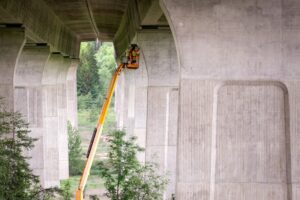In charge of theme 2 (WG2)
Myriam CARCASSES – INSA Toulouse (myriam.carcasses@iut-tlse3.fr)
Eric BROUARD – LAFARGE (eric.brouard@lafarge.com)
The objective of this working group is to identify eligible performance thresholds for each exposure class of the en NF EN 206-1 and for different work lifetimes.
The action plan is as follows:
 In the ‘absolute’ performantial approach, the performance is reached if the indicator(s) concerned fulfill a preset threshold for the considered exposure classes. The fulfill of the threshold indicates that concrete, in the environmental conditions pre-identified, ensures required durability. For degradation and lifetime, the threshold corresponds to the achievement of a limit state at the end of the predicted life expectancy. A threshold is valid for: a lifetime, a exposure class, an indicator and a corresponding limit state boundary. Note also that the performance limit is valid for a given coating. Finally, it may depend on the nature of concrete (cement, additions). Thus the couple (indicator, threshold) is fundamental because it lead all of the approach.
In the ‘absolute’ performantial approach, the performance is reached if the indicator(s) concerned fulfill a preset threshold for the considered exposure classes. The fulfill of the threshold indicates that concrete, in the environmental conditions pre-identified, ensures required durability. For degradation and lifetime, the threshold corresponds to the achievement of a limit state at the end of the predicted life expectancy. A threshold is valid for: a lifetime, a exposure class, an indicator and a corresponding limit state boundary. Note also that the performance limit is valid for a given coating. Finally, it may depend on the nature of concrete (cement, additions). Thus the couple (indicator, threshold) is fundamental because it lead all of the approach.
These research and developments are necessary but not sufficient and need to be confirmed and supplemented by a feedback of the real behaviour of structures in their environment. In other words, it is proposed here nor a fitting of the thresholds by the input data but a fitting of the thresholds by the output data in addressing the ageing of a panel of representative structures: environment (exposure classes), date of construction, age and nature of concrete (formulation). At minimum, the panel can cover old structures (70 to 100 years) and midde old strucutures (30-50 years) in marine and inland condition, in each age class concretes with CEM I, CEM II and CEM III. Ideally, diagnostic results are already available for these structures.
Identification of formulation and manufacturing parameters that are mostly influencing the durability of the materials containing cement
- Use of the “Sustainability indicators” database developed by the AFGC
- Use of the results obtained on concretes characterised in the context of the National project
- Model linking formulation and manufacturing parameters with durability indicators
Fitting of thresholds on old structures
- Former test body: BHP2000
- Old works
- launch of a natural ageing campaign
